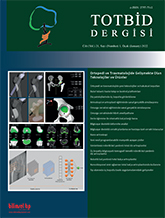
There has been a very rapid increase in the number of Total Knee Arthroplasties (TKAs) in the last 20 years. This has increased the expectation of better results and patient satisfaction. Robotic arm assisted total knee arthroplasty (rTDA), one of the intelligent orthopedic applications, has gained momentum in recent years with the use of imaging, image processing and artificial intelligence technologies and has entered clinical use. One of the most important arguments of robotic arm assisted TKA is the reduction of human error. Robotic arm assisted total knee arthroplasty aims to perform the surgery ideally and flawlessly in a reproducible manner for each case. It acts as a surgery assistant, enabling the surgeon to understand the deformity more easily, to make a better planning, and then to implement the plan with perfect precision. It is foreseen to reduce the risks of complications during and after the operation by providing convenience and accuracy to the surgeon in preoperative planning and during the operation. There are different robotic systems on different platforms. Imageless, semi-active, semi-closed indirect robotic devices assist the surgeon in making error-free incisions with the help of the robotic arm in line with the surgeon`s planning by creating a virtual map of the knee with software based on the anatomical reference points determined by the surgeon during the surgery. No need for computed tomography reduces radiation exposure and provides cost and time advantages.